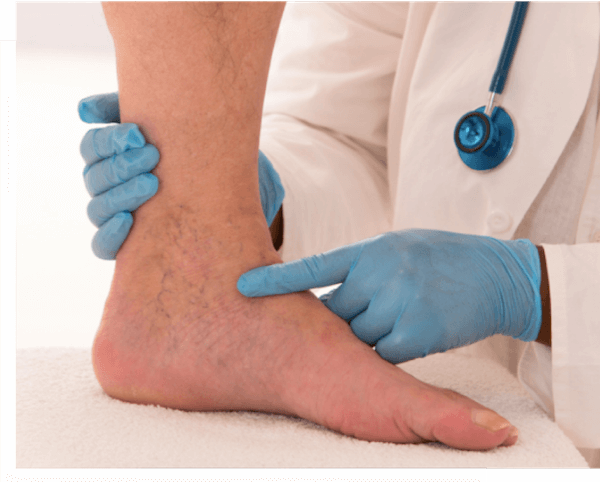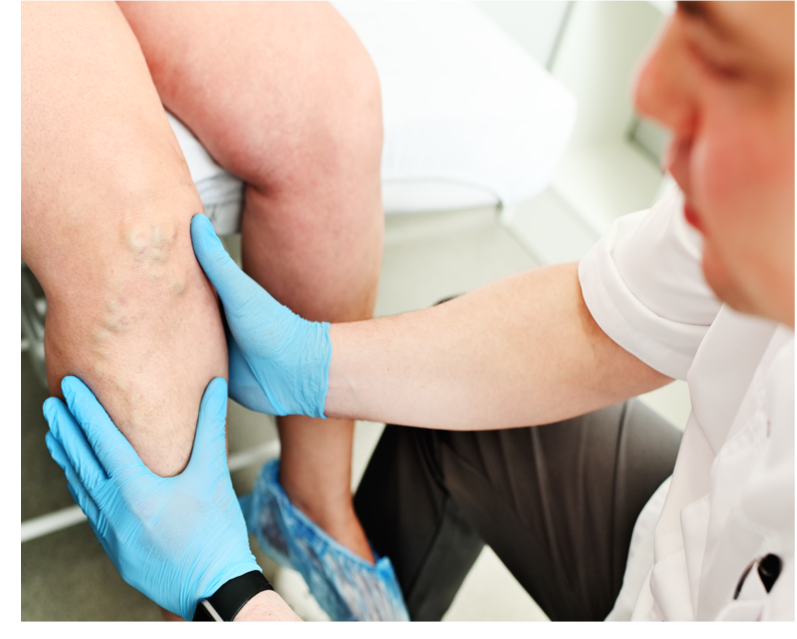Chronic Venous Insufficiency Stages Explained

Chronic venous insufficiency stages are used to classify the venous insufficiency for treatment plans. Chronic venous insufficiency is a progressive disease that spans several unique presentations, from spider veins and leads to varicose veins, eczema, atrophie blanche, corona phlebectatics, & venous ulcers in the late stages. Disease progression can take several years if not decades, causing many patients and practitioners to dissociate the severe manifestations of end-stage venous insufficiency from the cosmetic consequences of early-stage disease.
Fortunately, the recently revised CEAP scale provides a comprehensive framework to classify the many stages of chronic venous insufficiency, and helps to explain the continuity from cosmetic to medically severe. Our vascular specialists provide an in-depth overview of the CEAP scale and the different stages of venous insufficiency in this review.
Chronic Venous Insufficiency CEAP Scale
C0: No signs of venous insufficiency
C1: Telangiectasia (spider veins) or reticular veins
C2: Varicose veins
C3: Edema (swelling)
C4a: Pigmentation or eczema
C4b: Lipodermatosclerosis or atrophie blanche
C4c: Corona phlebectatica
C5: Healed venous ulcer
C6: Active venous ulcer
CA: Asymptomatic
CS: Symptomatic

Vein Specialist
Dr. Michael Lalezarian
Chronic Venous Insufficiency (CVI)
We’ll begin our review by first explaining why the different venous insufficiency stages occur. The underlying cause of venous insufficiency is a phenomenon known as venous reflux, which describes the backward flow of blood in the veins. Healthy veins have one-way valves that open to allow blood to flow towards the heart, and close to prevent flow in the opposite direction. In the case of venous reflux, vein valves malfunction and allow blood to flow backwards, causing blood to pool and pressure to increase in the affected vein.
Cosmetically, venous reflux is apparent in the form of spider veins and varicose veins, but reflux tends to affect more than just the veins themselves. When blood accumulates in the veins, it leaks out into surrounding tissues, causing the leg to become swollen and heavy. Over time, stagnant blood can also cause an inflammatory reaction, leading to fibrosis (thickening and scarring of tissue), and ulceration (breakdown of the skin) in the most severe cases. Individuals can also experience these stages of chronic venous insufficiency if they have an obstruction somewhere in their venous system, such as a blood clot (thrombosis).
To understand why venous insufficiency tends to get worse over time, the venous system in the leg can be thought of as a network of interconnected pipes. If one vein gets backed up due to reflux, the increased pressure is ‘felt’ along the length of the vein, and by the branching vessels connected to that vein.

CEAP Scale: Chronic Venous Insufficiency Stages
The CEAP scale is used to grade the severity of chronic venous insufficiency. CEAP stands for Clinical grade, Etiology, Anatomy, and Pathophysiology. Based on physical examination, individuals with chronic venous insufficiency can be graded from C0 (no signs of vein disease) to C6 (active venous ulcer). The CEAP scale helps to communicate both the clinical symptoms and the underlying cause of each stage of venous insufficiency, and has been used by vascular specialists for over 20 years. More detail on each stage is provided in the following sections. See venous insufficiency pictures.
Stage C0: No Signs of Venous Insufficiency
Venous insufficiency stage C0 describes individuals that have no outward signs of venous insufficiency. However, this designation does not rule out venous insufficiency symptoms (see section CS below).
Stage C1: Telangiectasia or Reticular Veins
Early stage venous insufficiency C1 applies when telangiectasia (spider veins) or reticular veins (small rope-like veins) are visible on the leg. These cosmetic alterations develop in the small veins just under the skin. It’s actually quite common for individuals to have stage C1 disease that never advances to more serious stages of venous insufficiency, so spider veins and reticular veins alone aren’t a cause for concern unless you’re also experiencing symptoms (see section CS below).
Stage C2: Varicose Veins
Early stage venous insufficiency C2 describes the visible presence of varicose veins. Varicose veins develop as venous insufficiency begins to affect the larger superficial veins, such as the great saphenous vein (GSV) or the small saphenous vein (SSV). Varicose veins are large (≥3 mm) and tortuous and can appear as a single coursing vein or as intermittent fluid-filled bumps along the surface of the leg.
More recent revisions of the CEAP scale also include a venous insufficiency stage C2r, where the “r” indicates that varicose veins “recur” in the years that follow successful treatment.
Stage C3: Edema (Swelling)
Stage C4a: Pigmentation or Eczema
Stage C4b: Lipodermatosclerosis or Atrophie Blanche
Venous insufficiency stage C4b indicates the presence of lipodermatosclerosis and/or atrophie blanche varicose veins. Fibrin is a key structural component of the vein, but as the vein is damaged, it can leak out and deposit into the skin. This leads to thickening and scar-like formation, making the skin feel tough and inflexible. Lipodermatosclerosis is thickening with continued red-brown coloration, but atrophie blanche is lighter or whiter in color.
Stage C4c: Corona Phlebectatica
Stage C5: Healed Venous Ulcer
Stage C6: Active Venous Ulcer
Vein Screening in Los Angeles

CA: No Symptoms of Venous Insufficiency
Where the numeric CEAP scale is used to designate visible signs of venous insufficiency, the designators “CS” and “CA” are used to describe the presence or absence of non-visible venous insufficiency symptoms. CA indicates asymptomatic venous insufficiency.
CS: Symptoms of Venous Insufficiency
Where the numeric CEAP scale is used to designate visible signs of venous insufficiency, the designators “CS” and “CA” are used to describe the presence or absence of non-visible venous insufficiency symptoms. CS indicates symptomatic venous insufficiency.
Vein Screening
Stages of Venous Insufficiency
Learn about the stages of venous insufficiency, from spider veins to venous leg ulcers.
Vein Screening
We break down each step in the diagnosis of vein disease so you know what to expect.
Vein Treatment in Los Angeles
Learn about your vein treatment options, including foam sclertherapy, Venaseal, and thermal ablation.
Learn how minimally invasive vein treatments can help accelerate healing.
Learn more about Los Angeles Vein Specialist Dr. Michael Lalezarian.
Schedule Your Visit
Click the Chat Button
Vascular Care in Los Angeles
& San Bernardino County
Adelanto
Alhambra
Amboy
Angelus Oaks
Apple Valley
Arcadia
Azusa
Baker
Baldwin Park
Barstow
Bell Gardens
Big Bear City
Big Bear Lake
Bloomington
Blue Jay
Bryn Mawr
Burbank
Cedar Glen
Cedarpines Park
Chino
Chino Hills
Cima
Citrus
City of Industry
Claremont
Colton
Covina
Crestline
Daggett
Diamond Bar
Downey
Duarte
Eagle Rock
Earp
El Monte
Essex
Fawnskin
Fontana
Forest Falls
Fort Irwin
Glendale
Glendora
Grand Terrace
Green Valley Lake
Guasti
Hacienda Heights
Helendale
Hesperia
Highland
Highland Park
Hinkley
Irwindale
Joshua Tree
La Canada
La Crescenta
La Habra
La Mirada
La Puente
La Verne
Lake Arrowhead
Landers
Loma Linda
Lucerne Valley
Ludlow
Lytle Creek
Mentone
Monrovia
Montclair
Montebello
Monterey Park
Morongo Valley
Mountain Pass
Mt Baldy
Needles
Newberry Springs
Nipton
Norwalk
Ontario
Oro Grande
Parker Dam
Pasadena
Phelan
Pico Rivera
Pinon Hills
Pioneertown
Pomona
Rancho Cucamonga
Redlands
Rialto
Rimforest
Rosemead
Running Springs
San Bernardino
San Dimas
San Gabriel
Santa Fe Springs
Sierra Madre
Skyforest
South El Monte
South Pasadena
Sugarloaf
Temple City
Trona
Twentynine Palms
Twin Peaks
Upland
Victorville
Vidal
Walnut
West Covina
West San Dimas
Whittier
Wrightwood
Yermo
Yucaipa
Yucca Valley




